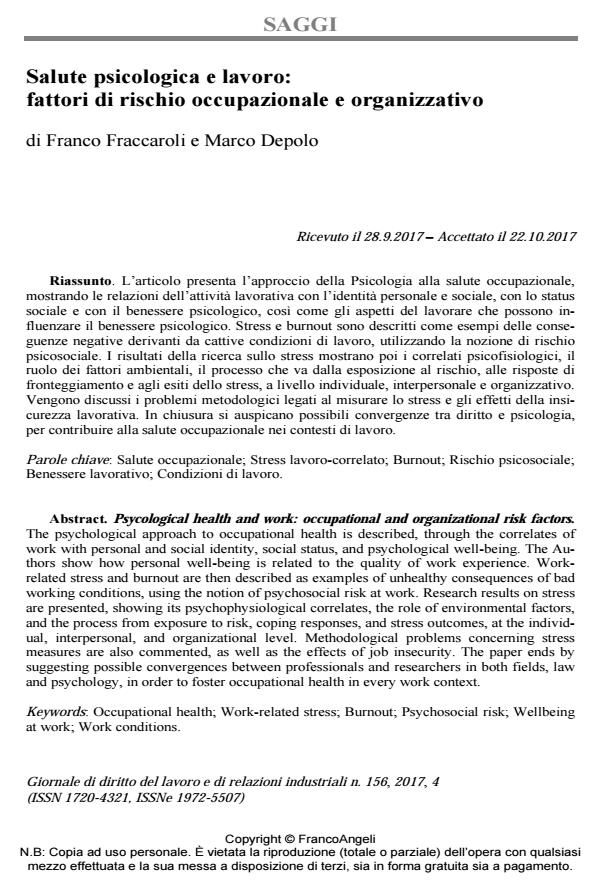Psycological health and work: occupational and organizational risk factors
Journal title GIORNALE DI DIRITTO DEL LAVORO E DI RELAZIONI INDUSTRIALI
Author/s Franco Fraccaroli, Marco Depolo
Publishing Year 2017 Issue 2017/156
Language Italian Pages 24 P. 639-662 File size 318 KB
DOI 10.3280/GDL2017-156001
DOI is like a bar code for intellectual property: to have more infomation
click here
Below, you can see the article first page
If you want to buy this article in PDF format, you can do it, following the instructions to buy download credits

FrancoAngeli is member of Publishers International Linking Association, Inc (PILA), a not-for-profit association which run the CrossRef service enabling links to and from online scholarly content.
The psychological approach to occupational health is described, through the correlates of work with personal and social identity, social status, and psychological well-being. The Authors show how personal well-being is related to the quality of work experience. Work-related stress and burnout are then described as examples of unhealthy consequences of bad working conditions, using the notion of psychosocial risk at work. Research results on stress are presented, showing its psychophysiological correlates, the role of environmental factors, and the process from exposure to risk, coping responses, and stress outcomes, at the individual, interpersonal, and organizational level. Methodological problems concerning stress measures are also commented, as well as the effects of job insecurity. The paper ends by suggesting possible convergences between professionals and researchers in both fields, law and psychology, in order to foster occupational health in every work context.
Keywords: Occupational health; Work-related stress; Burnout; Psychosocial risk; Wellbeing at work; Work conditions.
- Analysis of a New Work-Related Stress Assessment Tool Gaetano Buonocore, Nelson Mauro Maldonato, Yari Mirko Alfano, Simona Annunziata, Tilde Annunziato, Benedetta Muzii, Concetta Vergati, Mario Bottone, Daniela Cantone, Rita Polito, Nicola Tartaglia, Antonio Ambrosi, Carmela Robustella, Fiorenzo Moscatelli, Raffaele Sperandeo, in The Open Neurology Journal /2020 pp.32
DOI: 10.2174/1874205X02014010032
Franco Fraccaroli, Marco Depolo, Salute psicologica e lavoro: fattori di rischio occupazionale e organizzativo in "GIORNALE DI DIRITTO DEL LAVORO E DI RELAZIONI INDUSTRIALI " 156/2017, pp 639-662, DOI: 10.3280/GDL2017-156001